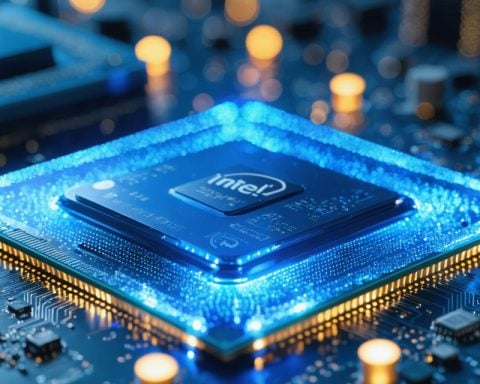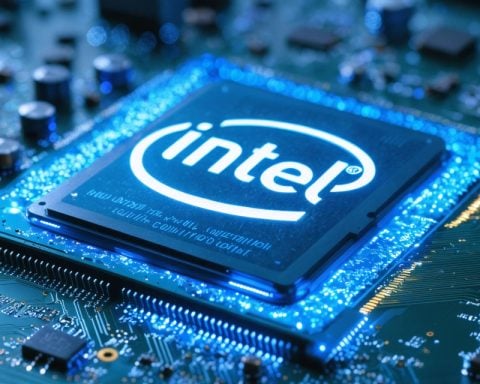- Arm Holdings’ stock has dramatically increased since its September 2023 market debut, reflecting strong investor confidence.
- Arm plans to shift from its traditional licensing model to manufacturing its own branded chips for data centers by summer, attracting significant attention.
- This strategic pivot could strain relationships with existing clients like Nvidia and Apple, who may consider alternate architectures like x86.
- Masayoshi Son, chairman of Softbank, spearheads this strategy, viewing it as essential for succeeding in the AI revolution.
- Investors face uncertainty: Will Arm’s bold move ensure dominance, or fracture its foundational alliances?
Imagine a shimmering horizon where data centers thrumming with energy-conscious chips redefine our digital landscape. Arm Holdings, a stalwart in the world of chip architecture, stands poised on this cutting edge. Since its market debut in September 2023, Arm’s stock has soared from $51 to a blistering $159, painting a portrait of investor optimism. But now, a seismic shift looms on the horizon.
In the secretive corridors of Silicon Valley, whispers grow louder. Arm, known for its energy-efficient dominance in smartphones, appears ready to transcend its traditional licensing model. Instead of simply sharing its blueprints, the company plans to craft its own Arm-branded chips for data centers. Reports suggest that this ambitious plan should produce ready-to-launch chips by this summer, with a major tech player already onboard as its first customer.
This new ambition, however, is not without peril. By stepping into the ring as a chip manufacturer, Arm risks alienating its current clientele, which spans industry titans like Nvidia and Apple. The possibility of confrontation—Arm versus its own customers—could drive these giants into the arms of x86, a competing architecture eager to tighten its grip.
Behind Arm’s colossal gamble is Masayoshi Son, the visionary chairman of Softbank, which owns the lion’s share of Arm. Son, ever the audacious strategist, sees this bold move as a necessary pivot toward the AI revolution he predicts. Yet this urgency might stem from past regrets, such as Softbank’s ill-timed sale of Nvidia shares years ago, now worth billions more.
As Arm charts this unchartered course, investors must watch keenly. Will Arm’s gamble pay off, or will it fracture the very foundation upon which it built its empire? Only time will tell in this narrative of risk, vision, and high-stakes transformation.
Arm Holdings’ Daring Leap into Chip Manufacturing: What It Means for the Future
How-To Steps & Life Hacks
For businesses looking to navigate the evolving chip landscape, especially if considering a partnership with Arm’s forthcoming products, the following steps are advisable:
1. Evaluate Current Needs: Assess your existing infrastructure and future requirements to determine if Arm’s data center chips align with your business needs.
2. Stay Informed: Keep abreast of Arm’s announcements and product specifications as the market can swiftly change.
3. Pilot Programs: Consider participating in pilot programs to test Arm’s chips in your environment before full-scale adoption.
Real-World Use Cases
The shift to Arm-branded chips offers several practical applications:
– AI Workloads: Arm’s energy-efficient chip designs are suitable for AI processing, benefiting companies with large AI workloads.
– Environmental Sustainability: Firms looking to reduce their carbon footprint will find Arm’s energy-conscious chips advantageous.
Market Forecasts & Industry Trends
The semiconductor industry is expected to expand significantly, with growth driven by AI, IoT, and data centers:
– Gartner projects a semiconductor market growth rate of around 6% annually over the next few years.
Arm Holdings, entering as a manufacturer, could capture a notable share by offering proprietary advantages.
Reviews & Comparisons
Arm’s new ventures will likely be compared to established players like Intel, AMD, and Nvidia:
– Performance: Chips need to rival Nvidia’s offerings for GPU workloads.
– Energy Efficiency: They need to be on par or better than Intel for data center efficiency.
Controversies & Limitations
The primary controversy surrounds Arm’s relationship with current customers:
– Alienation Risk: Major clients could shift to x86 or RISC-V architectures if they perceive Arm as a competitor rather than a supplier.
Features, Specs & Pricing
While specific details on the features and pricing of Arm’s upcoming chips are limited, expectations are:
– Architecture: An updated architecture focused on AI and data processing.
– Competitive Pricing: Pricing could be aggressive to establish market share quickly.
Security & Sustainability
Arm is likely to emphasize:
– Security: Implementing robust security features to protect against hardware vulnerabilities.
– Sustainability: Focusing on energy efficiency to contribute to greener data centers.
Insights & Predictions
Industry experts believe Arm’s entry into chip manufacturing could:
– Disrupt Market Dynamics: With potential displacement of traditional architectures.
– Accelerate AI Growth: Providing tailored solutions for AI applications.
Tutorials & Compatibility
For developers:
– Resources: Arm will likely release SDKs and development tools alongside chips.
– Compatibility: Ensuring backward compatibility with existing Arm-based architectures.
Pros & Cons Overview
Pros:
– Innovative Solutions: Custom-designed chips offer tailored benefits.
– Market Expansion: Access to new data center markets.
Cons:
– Customer Relationships: Risk of alienating key licensees.
– Market Risk: High stakes involved in shifting business models.
Actionable Recommendations
Keep informed about the progress of Arm’s projects and engage with their pilot programs to test new chips before broader implementation. Consider the growing importance of AI and sustainable practices in future tech strategies.
Arm Holdings will be a key player to watch as they navigate this transformational path.



















